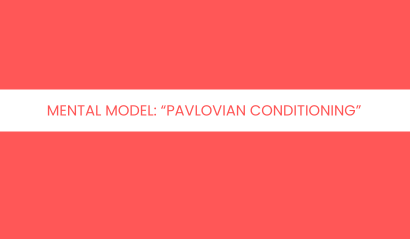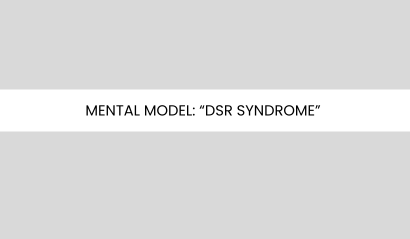Mental Model: Pavlovian Conditioning
Pavlovian Conditioning, also known as Classical Conditioning, is a fundamental learning process that has significantly influenced psychology, behavioral science, and even everyday life. Named after the Russian physiologist Ivan Pavlov, this type of learning involves associating a neutral stimulus with a naturally occurring stimulus to produce a conditioned response.
In this blog post, we will explore the origins of Pavlovian Conditioning, explain how it works, provide real-life examples, and discuss methods to avoid its unintended effects.
The Origins of Pavlovian Conditioning
The discovery of Pavlovian Conditioning dates back to the late 19th and early 20th centuries when Ivan Pavlov was conducting research on the digestive system of dogs. During his experiments, he noticed an interesting phenomenon: the dogs began salivating not only when food was presented but also when they saw the lab assistant who fed them. This observation led Pavlov to investigate the psychological mechanisms underlying this behavior.
Through controlled experiments, Pavlov demonstrated that by consistently pairing a neutral stimulus (such as a bell sound) with an unconditioned stimulus (food), the dogs eventually began salivating upon hearing the bell alone, even without the presence of food. This marked the foundation of Classical Conditioning.
Understanding the Mechanism of Pavlovian Conditioning
Pavlovian Conditioning involves several key components:
- Unconditioned Stimulus (US) – A stimulus that naturally and automatically triggers a response. (e.g., food that causes salivation in dogs)
- Unconditioned Response (UR) – A natural response that occurs due to the unconditioned stimulus. (e.g., salivation when food is presented)
- Neutral Stimulus (NS) – A stimulus that initially has no effect on the response. (e.g., a bell sound)
- Conditioned Stimulus (CS) – A previously neutral stimulus that, after association with the unconditioned stimulus, triggers a response. (e.g., the bell sound after being repeatedly paired with food)
- Conditioned Response (CR) – A learned response to the conditioned stimulus. (e.g., salivation upon hearing the bell alone)
Through repeated pairings, the previously neutral stimulus becomes a conditioned stimulus, producing a conditioned response similar to the original unconditioned response.
Real-Life Examples of Pavlovian Conditioning
1. Marketing and Advertising
Marketers often use Classical Conditioning to influence consumer behavior. For example, an advertisement featuring a happy family enjoying a soft drink creates an association between the beverage and happiness. Over time, consumers may begin associating the brand with positive emotions, increasing the likelihood of purchasing the product.
2. Phobias and Fears
Many fears and phobias develop due to Pavlovian Conditioning. For instance, a child who experiences a painful fall while playing with a dog may associate dogs with pain and fear. As a result, they might develop a lifelong fear of dogs.
3. Food Aversions
A common example of Classical Conditioning is food aversion. If a person consumes a particular food and later experiences food poisoning, they may develop an aversion to that food, even if the illness was caused by something else.
4. Emotional Responses
Certain smells, songs, or locations can evoke emotional responses due to past experiences. For example, a particular song that played during a breakup might trigger feelings of sadness when heard again, even years later.
5. Workplace Associations
If an employee frequently experiences stress and pressure in a particular office environment, they may develop an association between the workplace and stress. Even entering the office building might trigger feelings of anxiety.
The Role of Pavlovian Conditioning in Everyday Life
While Pavlovian Conditioning can be beneficial in some cases, such as in therapy or habit formation, it can also lead to unwanted behaviors and psychological associations. Understanding how conditioning occurs helps us become more aware of its effects and enables us to counteract its negative consequences.
How to Avoid Unwanted Pavlovian Conditioning
1. Recognizing Conditioned Triggers
Awareness is the first step in avoiding unwanted conditioning. Identifying triggers that lead to undesired responses allows individuals to address them proactively. For example, if a person notices that stress in the workplace is triggered by a particular sound or environment, they can take steps to modify their response.
2. Counterconditioning
Counterconditioning involves replacing an undesired conditioned response with a positive one. For example, if someone has a fear of public speaking due to past negative experiences, they can practice speaking in small, supportive environments to create positive associations.
3. Extinction Process
Extinction occurs when the conditioned stimulus is repeatedly presented without the unconditioned stimulus. Over time, the conditioned response weakens and eventually disappears. For example, if a person repeatedly hears a song associated with a past breakup in neutral settings, the emotional response may fade over time.
4. Avoiding Reinforcement of Negative Associations
If a person continues to avoid situations that trigger negative responses, it may reinforce the association. Instead, gradually exposing oneself to the stimulus in a controlled manner can help weaken the conditioned response.
5. Mindfulness and Cognitive Reframing
Practicing mindfulness and cognitive reframing can help change conditioned responses. If someone associates their workplace with stress, focusing on positive aspects of their job and implementing relaxation techniques can help shift their perspective.
Conclusion
Pavlovian Conditioning is a powerful psychological mechanism that influences behavior in numerous ways. From marketing strategies to emotional responses, it shapes many aspects of human life. While Classical Conditioning can be beneficial, it can also lead to unwanted associations that affect mental well-being.
By recognizing conditioned responses, utilizing counterconditioning techniques, and practicing mindfulness, individuals can better control how they react to stimuli. Understanding Pavlovian Conditioning not only enhances psychological awareness but also empowers individuals to reshape their behaviors and responses to the world around them.







